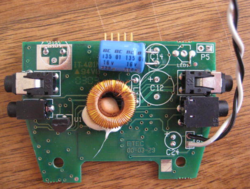PIR Sensors: Difference between revisions
(adding PIR PDF link) |
No edit summary |
||
| (8 intermediate revisions by 4 users not shown) | |||
| Line 1: | Line 1: | ||
<h2>PIR Sensors Info</h2> | |||
Pyroelectric devices, such as the PIR sensor, have elements made of a crystalline material that generates | |||
an electric charge when exposed to infrared radiation. The changes in the amount of infrared striking the | |||
element change the voltages generated, which are measured by an on-board amplifier. The device | |||
contains a special filter called a Fresnel lens, which focuses the infrared signals onto the element. As the | |||
ambient infrared signals change rapidly, the on-board amplifier trips the output to indicate motion. | |||
--From the PIRSensor-V1.1 pdf (linked below) | |||
<h2> PIR Sensor Datasheets</h2> | |||
pdf warning! | |||
[[image:PIR Sensor 2 Element Datasheet.pdf]]<br/> | |||
[[Image:PIRSensor-V1.1.pdf]] | |||
[[ | <h2>Schematics for PIR motion sensor boards</h2> | ||
Hundreds of circuit boards incorporating PIR motion sensors were donated to Noisebridge. They are available for use immediately, and they are currently located in the storage area of the 83c Mezzanine. | |||
There's a page for the schematics of these [[PIR motion sensor schematics|PIR motion sensor boards]] | |||
There's also a pdf of the same schematics at: [[image:PIR_SensorBoardSchematic.pdf]]<br/> | |||
and an [[PIR_motion_sensor_frontend_SPICE_simulation|LTspice schematic of the sensor front end circuit]]: [[image:PIR_review_001.doc]] (needs some extraction and installation) | |||
[[Image: | [[Image:03.PIR_Cellphone_Board2.png|250px]] | ||
PIR-less motion sensor board (see G101 for PIR placement location) | |||
[[Image: | [[Image:02_PIR_Cell.png|250px]] | ||
Backside of PIR motion sensor board | |||
[[ | On 4/7/09 I hooked up a scope to the sensor output (pin 8 on the PIC) and 12V on the power input (marked [P5], next to LED, polarity on bottom silkscreen) , and got lovely +5 logic high signal by waving my hand over the sensor, 300-400 ms long. These units are ready to rock! [[User:Jtfoote|Jtfoote]] 15:45, 7 April 2009 (PDT) | ||
Brainstorm ideas for projects incorporating this large number of boards and sensors: | |||
* Interactive coffee table like that from EMSL: http://www.evilmadscientist.com/article.php/tablekits ? | |||
Latest revision as of 17:51, 19 April 2009
PIR Sensors Info
Pyroelectric devices, such as the PIR sensor, have elements made of a crystalline material that generates an electric charge when exposed to infrared radiation. The changes in the amount of infrared striking the element change the voltages generated, which are measured by an on-board amplifier. The device contains a special filter called a Fresnel lens, which focuses the infrared signals onto the element. As the ambient infrared signals change rapidly, the on-board amplifier trips the output to indicate motion.
--From the PIRSensor-V1.1 pdf (linked below)
PIR Sensor Datasheets
pdf warning!
File:PIR Sensor 2 Element Datasheet.pdf
File:PIRSensor-V1.1.pdf
Schematics for PIR motion sensor boards
Hundreds of circuit boards incorporating PIR motion sensors were donated to Noisebridge. They are available for use immediately, and they are currently located in the storage area of the 83c Mezzanine. There's a page for the schematics of these PIR motion sensor boards
There's also a pdf of the same schematics at: File:PIR SensorBoardSchematic.pdf
and an LTspice schematic of the sensor front end circuit: File:PIR review 001.doc (needs some extraction and installation)
 PIR-less motion sensor board (see G101 for PIR placement location)
PIR-less motion sensor board (see G101 for PIR placement location)
 Backside of PIR motion sensor board
Backside of PIR motion sensor board
On 4/7/09 I hooked up a scope to the sensor output (pin 8 on the PIC) and 12V on the power input (marked [P5], next to LED, polarity on bottom silkscreen) , and got lovely +5 logic high signal by waving my hand over the sensor, 300-400 ms long. These units are ready to rock! Jtfoote 15:45, 7 April 2009 (PDT)
Brainstorm ideas for projects incorporating this large number of boards and sensors:
- Interactive coffee table like that from EMSL: http://www.evilmadscientist.com/article.php/tablekits ?